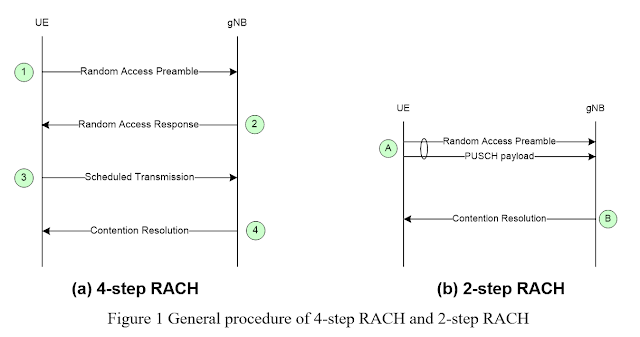NR-U Layer 2 (Candidates)
Note: NR-Unlicensed is still in the study phase with barely any work done on the TS. It is expected that by 2022 (so Release 18) we may see some specification for the 6GHz band in Europe. As of now, only potential candidates for NR-U implementation can be guessed.
RACH (4-step, 2-step)
Both 4-step and 2-step RACH will be
supported for NR-U. Here 2-step RACH refers to the procedure which can complete
contention-based RACH (CBRA) in two steps as explained below. One additional
benefit of 2-step RACH is due to less LBT impact with the reduced number of
messages. However, in order to alleviate the impact of LBT failures further,
additional opportunities for the RACH messages may be introduced, e.g. in time
or frequency domain, for both 4-step and 2-step RACH. The additional opportunities for 4-step RACH
will be applicable to both msg1 and msg3.
NR-U
will support contention-free RACH (CFRA) and CBRA for both 2-step and 4-step
RACH. On SCells, CFRA is supported as a baseline while both CBRA and CFRA are
supported on SpCells.
For
4-step RACH, the messages in time order are named as msg1, msg2, msg3, msg4 and
for 2-step RACH, they are named msgA and msgB.
A
single RACH procedure will be used and thus multiple RACH procedures in
parallel will not be supported for NR-U.As a baseline, the random-access
response to msg1 will be on SpCell and msg3 is assumed to use a predetermined
HARQ ID.
In
legacy RACH, the counters for preamble transmission and power ramping are
increased with every attempt. In NR-U, power ramping is not applied when
preamble is not transmitted due to LBT failure. This will require an indication
from the physical layer to the MAC. In addition, ra-ResponseWindow is not started when
the preamble is not transmitted due to LBT failure.
It is assumed that ra-ContentionResolutionTimer may need to be extended
with larger values to overcome the LBT impact.
For 2-step RACH, the msgA is a signal to detect the UE and a payload while the second message is for contention resolution for CBRA with a possible payload. msgA will at least include the equivalent information which is transmitted in msg3 for 4-step RACH.
As a baseline, all the triggers for 4-step
RACH are also applicable to 2-step RACH; however further analysis is needed on
SI request and BFR as well as how timing advance and grants can be obtained for
msgA.
The contention resolution in 2-step RACH
will be performed by including a UE identifier in the first message which is
echoed in the second message. The type of UE identifier(s) is FFS.
Fall-back from 2-step RACH to 4-step RACH
will be supported. The fallback after msgA transmission is feasible only if
detection of the UE without the decoding of the payload is possible and thus
relies on such support at the physical layer.
If 2-step
RACH is used for initial access, the parameters for 2-step RACH procedure
including resources for msgA will be broadcasted.
NOTE: 2-step RACH
if applied to licensed operation would not take into account LBT.
MAC (except RACH)
For scheduling request (SR), a prohibit
timer as in NR licensed can be used. However, this should not prevent the UE
from attempting to transmit an SR again if the triggered SR was not transmitted
due to LBT failure.
Other
For channel access
and transmissions in NR-U the mechanisms and associated signaling adopted by
LTE LAA (e.g. standardized QCI to access priority mapping for DL and UL, how
access priority per logical channel is determined for scheduled UL and AUL
transmissions etc) are used as the baseline. Any changes due to new physical
layer design and channel access mechanisms for NR-U (e.g. introduction of
PRACH, support of FBE) can also be introduced.
In addition,
access priority for control signaling (transmissions over SRBs) over unlicensed
carriers should be introduced for stand-alone and DC NR-U. In this case, it is
assumed that control signaling will have the highest access priority.
Related:
